This guest post by Nia McRae appears as part of our theme week on Children’s Television.
Everyone from Bill Cosby to the creators of South Park seemed baffled and amused by the Pokemon craze of the 90s. It still holds a place in the hearts of many millennials because although its obvious aim was to sell products, it didn’t change that the show had a lot of wit and heart. It’s easy to tell a lot of effort went into the episode ideas, world-building, character building, and dialogue. However, most of the people who were adults when the television show first appeared were, and still are, mystified by its appeal. So, I’ll try to explain the show to people who aren’t enthusiasts. Pokemon is an Anime-otherwise known as a Japanese cartoon-that was translated into English by the production company, 4Kids Entertainment. The word Pokemon is short for Pocket Monsters.
Pokemon is still an ongoing series but my focus will be on the first season. The protagonist is Ash Ketchum, a 10-year old whose traveling companions are Brock and Misty. He wants to be a Pokemon Master, a goal which involves using the pokemon you catch to defeat numerous Gym Leaders and collect badges.
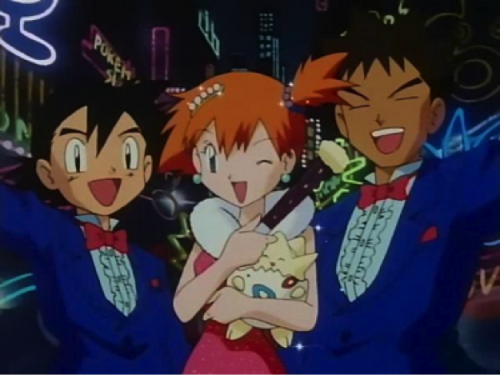
The show itself featured a world where people catch and train super-powered animal-like beings called pokemon. Humans used Pokeballs to catch pokemon. There are many pokemon-related options that exist such as becoming a Pokemon Breeder or a Pokemon Master.
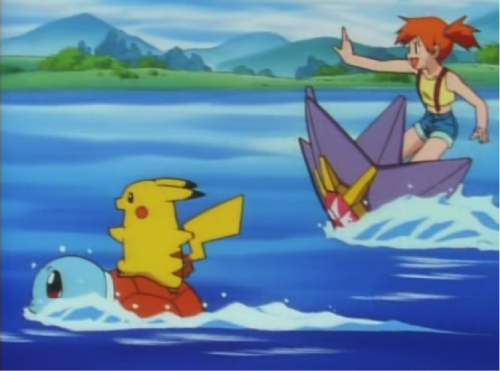
So, should a writer depict a world that mirrors reality and show the problems within it or should s/he depict the ideal world we want to live in? Pokemon leans more to the latter. Pokemon, just like Star Trek, depicts a world that’s egalitarian or at the very least, very close to it. It’s a world where gender, race, and sexual orientation appear to be irrelevant. As a kid, I couldn’t articulate very well why I loved Pokemon so much but now I can. My joy was due to many things in the show; the adventures which encouraged my love of travel, the fun and catchy songs and most notably, the strong presence of dynamic, ambitious, and fun female characters.
Whenever I watched Pokemon as a kid, I remember finding it refreshing that whenever a female character appeared as a challenger, there was never any shock or amusement on a male character’s face. Female characters being in positions of power were simply an unexceptional fact of life in the pokemon universe. Another thing that wasn’t a big deal in the pokemon world (but of course would be in real life) is the fact that 10-year kids were allowed to roam the earth without parental supervision. But Pokemon wasn’t meant to reflect real life in terms of the dangers and limitations of reality. It was an escapist fantasy which encouraged kids to learn new things and meet new people. It certainly made me look forward to being an adult and having the freedom of Ash and friends.
It had really funny moments and witty lines that still make me laugh when I revisit an episode or two. All of the characters-whether male or female, minor or major, pokemon or human-had distinct personalities and styles.
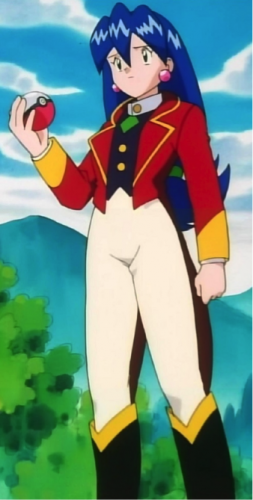
Boys were shown as Gym Leaders and so were girls in many instances. In fact, one of Ash’s most formidable opponents was a psychic Gym Leader named Sabrina. She was creepy because she had telekinetic powers and she had psychological issues. Luckily, her mental problems weren’t caused by man troubles. Ash’s struggle to defeat her took a whole three episodes.

One of my favorite characters was Duplica (yes, that was her actual name) who was working to be an Impressionist along with her shape-shifting pokemon, Ditto. She was a fun and feisty tomboy who could dress up and imitate anyone whether boy or girl. And just like Sabrina, she challenged Ash to see his weaknesses and become a better pokemon trainer.
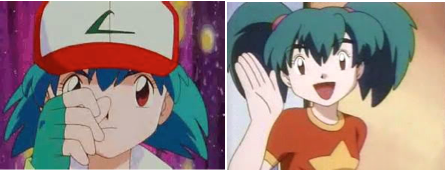
In addition to being Gym Leaders, female characters are found in other occupations: nurse, scientist, professor, rancher, police officer, etc. The show helped to normalize women in any position of power, whether it was common in real life or not. Similar to kid shows like The Magic School Bus or Captain Planet, its goal was to capture a kid’s imagination. Because the pokemon world is so egalitarian, there isn’t a need for any didactic speeches. Girls, just like boys, go out and do whatever they want to do without interference-and there’s a lot of power in normalizing that image.
There two most prominent female characters are Misty and Jessie. Misty is a water pokemon trainer. Her three sisters run the Cerulean Gym where trainers can win a Cascade badge. Her passion for water pokemon is showcased in an episode called “Tentecool and Tentacruel.” That same episode involves this scene:
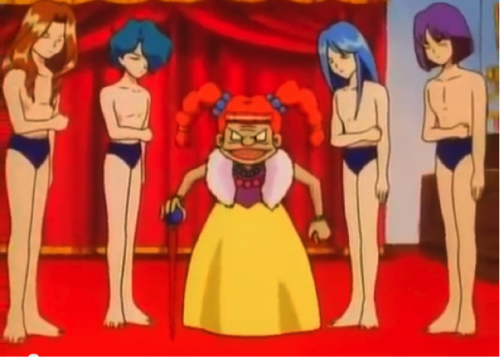
Jessie is part of the main trio of villains including James and a talking cat pokemon named Meowth. Jessie and James cross-dress a lot. Whenever they’re in disguise, sometimes they’re both wearing girl’s clothing or they’re both wearing guy clothes. Many times, Jessie wears the typical guy attire and James is enthusiastically in a girl’s outfit. There’s a lot of gay coding for James. His voice and mannerisms are foppish. This is part of an ongoing issue of coded gay characters being villains in movies and TV. The only silver lining is that James and Jessie aren’t depicted as people who should be feared or despised. At best, they’re just annoying. Many times, they serve as comic relief and there are even some moments where they’ve helped the heroes of the story.
But Pokemon was progressive in many other ways. It had people of ambiguous ethnic background. Ash, for example, had an olive skin tone and Brock was even tanner. Fans still wonder if Brock is Latino, Black or Southeast Asian. Another subversion of gender roles is that the male supporting character, Brock enjoyed making meals for his friends. He wore aprons and he carried cookware wherever he went. No one questioned his masculinity because of his domestic enjoyments. Ash seemed to come from a working class home and he was raised by a single mom. It was good for kids to see a positive depiction of a single mother. Seeing that the hero of the story came from a happy home with a single mother also helped kids from single-headed households to unconsciously know there’s no shame in it.
But even if there are progressive inclinations here and there, some gender stereotypes still appear. There’s an ongoing gag of Misty’s fear of bugs, propensity for romantic daydreams, and love of cute things. In the episode, “The Water Flowers of Cerulean City,” we meet Misty’s valley girl-sounding sisters. In that same episode, Ash battles Misty and she calls forth a jewel-like water pokemon which prompts Ash to mumble, “Leave it to a girl to show off her jewelry.” But Misty isn’t solely a girly-girl (though there would be nothing wrong if she were). There are many sides to her; she has traits associated with males such as being adventurous, rowdy, and temperamental. Her temper is shown to be her main flaw just as occasional dimwittedness is Ash’s central imperfection. She isn’t just one thing but a combination of traits-which is pretty complex for a kid’s show.
In later seasons, there were controversies around a female character named May because she was viewed as having stereotypical girlie aspirations such as competing in Pokemon Contests. It was seen as a step down because instead of vying for badges, the challenger battled for ribbons. Critics viewed it as an inferior dream because Pokemon Contests placed more emphasis on shallow things like beauty. But I never minded it because 1. It was treated as a legit and respected thing and 2. Boys were shown participating in it too. The beautiful thing about Pokemon is I never noticed any gender segregation. There was no pink ghetto.
However, there was a questionable episode called “Princess vs. Princess,” which involved a holiday (possibly satirizing Valentine’s Day?) that celebrated women. The holiday required guys to serve girls as they shop, participate in beauty contests and do many other girlie things (I can hear the accusations of “Feminazi” already). When the women are fighting over clothing, James comments, “I don’t think I’m tough enough to be a woman.” Again, I don’t mind the show featuring female characters doing stereotypical “girl” things because Pokemon was always good at showing the full range of girls. Not every girl in Pokemon embodied the girly-girl stereotype and even the ones that did had complexities to them (as much complexity as you get in a Pokemon cartoon, of course)
Sadly, as is true for many beloved side characters, Misty was rarely in the spotlight and the same was true for Brock. Ash’s personal journey is what garnered the most attention. But fans loved Brock and Misty-some people liked them even more than Ash. That’s why when Misty’s character was replaced by May, there was a huge outcry, particularly from preteens who wanted to see Ash and Misty as a couple. But the powers that be didn’t want romance to be a distraction. After all, it was still a kid’s show. Even if the executives wanted to squash any chance of romance, it still could be argued that getting rid of Misty was unnecessary. But in the long run, it helped to keep the show fresh. And she wasn’t gone for good; she returned for later episodes.
For those who still want more Misty, there’s a spin-off series called Pokemon Chronicles which include episodes that follow characters in the pokemon world other than Ash. Brock gets an episode and Misty features in several episodes. It was a pleasant surprise to see Misty being a main character in her own life which is beneficial for girls to see. In addition to her jewel-type and cute pokemon, she also gets to have a scary, badass pokemon; the serpentine dragon-like type called Gyarados. Pokemon Chronicles reveals a more mature side of Misty as she handles all the responsibilities of being a Gym Leader while her sisters are away. Though she is the youngest sister, she is shown to be the smartest and best-fit as leader. Just like any good leader, she is assertive when the time calls for it and nurturing when the time calls for it.
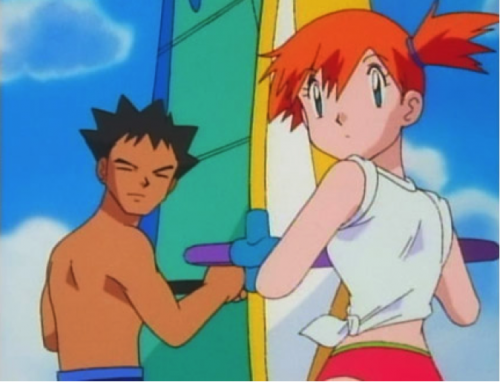
Of course, we can’t forget the merchandising. Even today, you can’t talk about any children’s show without discussing the main motivation of selling products. Because the stars of the show were obviously the pokemon more so than the human characters, it was easy to sell pokemon. But the human characters were still necessary in order to be relatable. Pokemon was the King of Advertising. The show’s tag line was “Gotta Catch ’Em All,” which was repeated ad nauseam to hypnotize kids into buying as many trading cards, toys, and games as possible. And it worked, especially in its heyday in the late 1990s. I recall a lot of girls buying the merchandise too. That’s why I think Pokemon serves as a lesson to executives that not only is it socially good but it’s a smart business idea to market to both boys AND girls. Pokemon still resonates with a lot of young people because it created a world that made everyone feel welcomed.
Nia McRae graduated summa cum laude from Medgar Evers College where she earned a Bachelor of Arts degree in Liberal Studies with a concentration in history. She has a strong passion for critiquing racial and gender politics in the media and putting it in historical context.

There are a lot of inaccuracies in this review that the author is just plain wrong about. For one thing there was no outcry over Misty leaving outside of young kids who had an obsession over Misty. Misty was permanently dropped from the show because her character was poorly received in the Johto arc for becoming stale and flat.
May was also one of the most popular characters in the series. The reason Misty was not revived was that May was so vastly preferred over her as a character for being better written and having a better storyline,
Lastly the Contest episodes were the most popular additions to the show and became a staple of it for over a decade. No idea why the author says critics viewed it as a step down when they were the best received additions to the series and made up for Misty’s lack of battles and focus.
The author clearly wrote this article out of nostalgia given the replacement of Misty with May was very well received and it prompted the writers to permanently drop Misty for the rest of the series. Amazing how someone can write an article and have no clue what she is talking about. Try researching the pokemon fandom someday.
From my perspective, the Pokémon anime series and the video games are quite neat, as well as very inspiring too. And that is one of the reasons why I like them. Another reason is that Pokémon helps me to challenge my brain with reading and arithmetic problems (which is shown in the names of the Pokémon and the experience points I get from each battle in the games).
And that is one of the reasons why I like them. Another reason is that Pokémon helps me to challenge my brain with reading and arithmetic problems (which is shown in the names of the Pokémon and the experience points I get from each battle in the games). 
All of this – and not a single thing about Brock constantly pestering and gawking over every woman he meets in the show? Brock is reminiscent of the self-described “nice guy” at the bar who won’t take no for an answer. I’m disappointed that you didn’t discuss such a major flaw with this character in the earlier Pokémon episodes. Not only did Brock set a poor example for boys, but he also served as comic relief, encouraging even girls to laugh at his persistent begging of women to marry him. It’s damaging to girls to teach boys that girls are nothing but trophies to be won, and it’s also damaging to boys to teach them that their ultimate goal in life should be to get as many girls as they can. It pushes boys to do things they might not really want to do, and it ends up hurting girls.
Everything else you said was pretty spot-on, though. I agree that Pokémon has a lot of feminist qualities, and it definitely set more of a good example overall than a bad one. But I really think it’s still important to point out the problems with it, such as the problem with Brock’s attitude towards women.